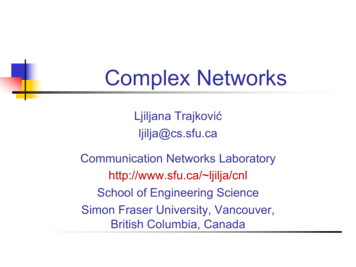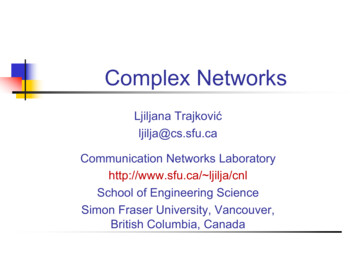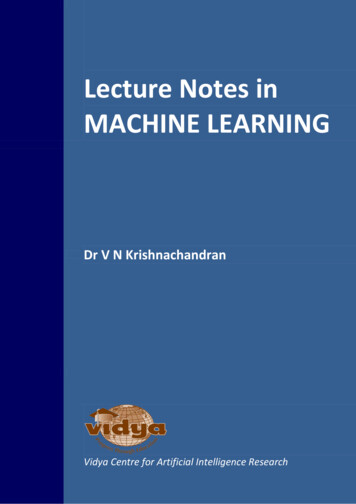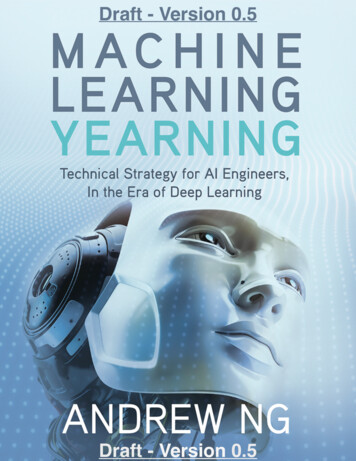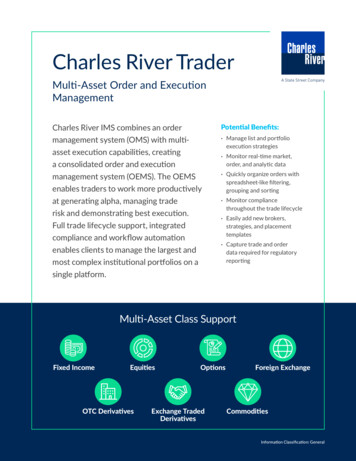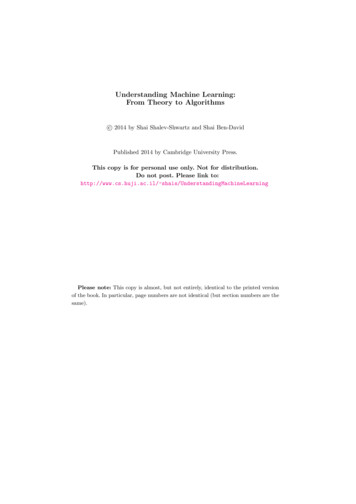
Transcription
Jason BrownleeMaster Machine Learning AlgorithmsDiscover How They Work and Implement Them From Scratch
iMaster Machine Learning Algorithms Copyright 2016 Jason Brownlee. All Rights Reserved.Edition, v1.1http://MachineLearningMastery.com
ContentsPrefaceIIntroduction1 Welcome1.1 Audience . . . . . . . . . . .1.2 Algorithm Descriptions . . .1.3 Book Structure . . . . . . .1.4 What This Book is Not . . .1.5 How To Best Use this Book1.6 Summary . . . . . . . . . .IIiii1.Background223355562 How To Talk About Data in Machine2.1 Data As you Know It . . . . . . . . .2.2 Statistical Learning Perspective . . .2.3 Computer Science Perspective . . . .2.4 Models and Algorithms . . . . . . . .2.5 Summary . . . . . . . . . . . . . . .Learning. . . . . . . . . . . . . . . . . . . . . . . . . .3 Algorithms Learn a Mapping From Input to Output3.1 Learning a Function . . . . . . . . . . . . . . . . . . .3.2 Learning a Function To Make Predictions . . . . . . . .3.3 Techniques For Learning a Function . . . . . . . . . . .3.4 Summary . . . . . . . . . . . . . . . . . . . . . . . . .4 Parametric and Nonparametric Machine Learning4.1 Parametric Machine Learning Algorithms . . . . . .4.2 Nonparametric Machine Learning Algorithms . . .4.3 Summary . . . . . . . . . . . . . . . . . . . . . . .7789910.1111121212Algorithms13. . . . . . . . . . . . . . . . 13. . . . . . . . . . . . . . . . 14. . . . . . . . . . . . . . . . 155 Supervised, Unsupervised and Semi-Supervised Learning165.1 Supervised Machine Learning . . . . . . . . . . . . . . . . . . . . . . . . . . . . 165.2 Unsupervised Machine Learning . . . . . . . . . . . . . . . . . . . . . . . . . . . 17ii
iii5.35.46 The6.16.26.36.46.5Semi-Supervised Machine Learning . . . . . . . . . . . . . . . . . . . . . . . . .Summary . . . . . . . . . . . . . . . . . . . . . . . . . . . . . . . . . . . . . . .1718Bias-Variance Trade-OffOverview of Bias and VarianceBias Error . . . . . . . . . . .Variance Error . . . . . . . .Bias-Variance Trade-Off . . .Summary . . . . . . . . . . .191920202021.2222222323232424.7 Overfitting and Underfitting7.1 Generalization in Machine Learning7.2 Statistical Fit . . . . . . . . . . . .7.3 Overfitting in Machine Learning . .7.4 Underfitting in Machine Learning .7.5 A Good Fit in Machine Learning .7.6 How To Limit Overfitting . . . . .7.7 Summary . . . . . . . . . . . . . .III.Linear Algorithms8 Crash-Course in Spreadsheet Math8.1 Arithmetic . . . . . . . . . . . . . .8.2 Statistical Summaries . . . . . . . .8.3 Random Numbers . . . . . . . . . .8.4 Flow Control . . . . . . . . . . . .8.5 More Help . . . . . . . . . . . . . .8.6 Summary . . . . . . . . . . . . . .25.262627282828299 Gradient Descent For Machine Learning9.1 Gradient Descent . . . . . . . . . . . . .9.2 Batch Gradient Descent . . . . . . . . .9.3 Stochastic Gradient Descent . . . . . . .9.4 Tips for Gradient Descent . . . . . . . .9.5 Summary . . . . . . . . . . . . . . . . .303031323233.343434353536373738.10 Linear Regression10.1 Isn’t Linear Regression from Statistics? . .10.2 Many Names of Linear Regression . . . . .10.3 Linear Regression Model Representation .10.4 Linear Regression Learning the Model . .10.5 Gradient Descent . . . . . . . . . . . . . .10.6 Making Predictions with Linear Regression10.7 Preparing Data For Linear Regression . . .10.8 Summary . . . . . . . . . . . . . . . . . .
iv11 Simple Linear Regression Tutorial11.1 Tutorial Data Set . . . . . . . . .11.2 Simple Linear Regression . . . . .11.3 Making Predictions . . . . . . . .11.4 Estimating Error . . . . . . . . .11.5 Shortcut . . . . . . . . . . . . . .11.6 Summary . . . . . . . . . . . . .12 Linear Regression Tutorial Using Gradient Descent12.1 Tutorial Data Set . . . . . . . . . . . . . . . . . . . . . . .12.2 Stochastic Gradient Descent . . . . . . . . . . . . . . . . .12.3 Simple Linear Regression with Stochastic Gradient Descent12.4 Summary . . . . . . . . . . . . . . . . . . . . . . . . . . .13 Logistic Regression13.1 Logistic Function . . . . . . . . . . . . . . .13.2 Representation Used for Logistic Regression13.3 Logistic Regression Predicts Probabilities . .13.4 Learning the Logistic Regression Model . . .13.5 Making Predictions with Logistic Regression13.6 Prepare Data for Logistic Regression . . . .13.7 Summary . . . . . . . . . . . . . . . . . . .40404043434545.4646464750.515152525354545514 Logistic Regression Tutorial14.1 Tutorial Dataset . . . . . . . . . . . . . . . . . . .14.2 Logistic Regression Model . . . . . . . . . . . . . .14.3 Logistic Regression by Stochastic Gradient Descent14.4 Summary . . . . . . . . . . . . . . . . . . . . . . .565657576015 Linear Discriminant Analysis15.1 Limitations of Logistic Regression15.2 Representation of LDA Models .15.3 Learning LDA Models . . . . . .15.4 Making Predictions with LDA . .15.5 Preparing Data For LDA . . . . .15.6 Extensions to LDA . . . . . . . .15.7 Summary . . . . . . . . . . . . .616162626263646416 Linear Discriminant Analysis Tutorial16.1 Tutorial Overview . . . . . . . . . . . .16.2 Tutorial Dataset . . . . . . . . . . . .16.3 Learning The Model . . . . . . . . . .16.4 Making Predictions . . . . . . . . . . .16.5 Summary . . . . . . . . . . . . . . . .656565676970.
vIVNonlinear Algorithms7117 Classification and Regression Trees17.1 Decision Trees . . . . . . . . . . . .17.2 CART Model Representation . . .17.3 Making Predictions . . . . . . . . .17.4 Learn a CART Model From Data .17.5 Preparing Data For CART . . . . .17.6 Summary . . . . . . . . . . . . . 939394959697.18 Classification and Regression Trees Tutorial18.1 Tutorial Dataset . . . . . . . . . . . . . . .18.2 Learning a CART Model . . . . . . . . . . .18.3 Making Predictions on Data . . . . . . . . .18.4 Summary . . . . . . . . . . . . . . . . . . .19 Naive Bayes19.1 Quick Introduction to Bayes’ Theorem19.2 Naive Bayes Classifier . . . . . . . . .19.3 Gaussian Naive Bayes . . . . . . . . .19.4 Preparing Data For Naive Bayes . . . .19.5 Summary . . . . . . . . . . . . . . . .20 Naive Bayes Tutorial20.1 Tutorial Dataset . . . . . .20.2 Learn a Naive Bayes Model20.3 Make Predictions with Naive20.4 Summary . . . . . . . . . . . . . . . .Bayes. . . .21 Gaussian Naive Bayes Tutorial21.1 Tutorial Dataset . . . . . . . . . . . . . . .21.2 Gaussian Probability Density Function . . .21.3 Learn a Gaussian Naive Bayes Model . . . .21.4 Make Prediction with Gaussian Naive Bayes21.5 Summary . . . . . . . . . . . . . . . . . . .22 K-Nearest Neighbors22.1 KNN Model Representation .22.2 Making Predictions with KNN22.3 Curse of Dimensionality . . .22.4 Preparing Data For KNN . . .22.5 Summary . . . . . . . . . . .98. 98. 98. 100. 100. 100.102. 102. 102. 104. 10523 K-Nearest Neighbors Tutorial23.1 Tutorial Dataset . . . . . . .23.2 KNN and Euclidean Distance23.3 Making Predictions with KNN23.4 Summary . . . . . . . . . . .
vi24 Learning Vector Quantization24.1 LVQ Model Representation . . . . . . . .24.2 Making Predictions with an LVQ Model24.3 Learning an LVQ Model From Data . . .24.4 Preparing Data For LVQ . . . . . . . . .24.5 Summary . . . . . . . . . . . . . . . . .25 Learning Vector Quantization25.1 Tutorial Dataset . . . . . .25.2 Learn the LVQ Model . . .25.3 Make Predictions with LVQ25.4 Summary . . . . . . . . . .Tutorial. . . . . . . . . . . . . . . . . . . . .26 Support Vector Machines26.1 Maximal-Margin Classifier . . . . .26.2 Soft Margin Classifier . . . . . . . .26.3 Support Vector Machines (Kernels)26.4 How to Learn a SVM Model . . . .26.5 Preparing Data For SVM . . . . . .26.6 Summary . . . . . . . . . . . . . .106106107107108108.110. 110. 111. 113. 114.115. 115. 116. 116. 118. 118. 11827 Support Vector Machine Tutorial27.1 Tutorial Dataset . . . . . . . . . . . . . .27.2 Training SVM With Gradient Descent . .27.3 Learn an SVM Model from Training Data27.4 Make Predictions with SVM Model . . . .27.5 Summary . . . . . . . . . . . . . . . . . .V.Ensemble Algorithms28 Bagging and Random Forest28.1 Bootstrap Method . . . . . . . . .28.2 Bootstrap Aggregation (Bagging) .28.3 Random Forest . . . . . . . . . . .28.4 Estimated Performance . . . . . . .28.5 Variable Importance . . . . . . . .28.6 Preparing Data For Bagged CART28.7 Summary . . . . . . . . . . . . . .119119120121123124125.29 Bagged Decision Trees Tutorial29.1 Tutorial Dataset . . . . . . . . . . . .29.2 Learn the Bagged Decision Tree Model29.3 Make Predictions with Bagged Decision29.4 Final Predictions . . . . . . . . . . . .29.5 Summary . . . . . . . . . . . . . . . . . . . . . .Trees. . . . . . .126. 126. 127. 127. 128. 128. 129. 129.130. 130. 131. 132. 134. 134
vii30 Boosting and AdaBoost30.1 Boosting Ensemble Method . . . .30.2 Learning An AdaBoost Model From30.3 How To Train One Model . . . . .30.4 AdaBoost Ensemble . . . . . . . .30.5 Making Predictions with AdaBoost30.6 Preparing Data For AdaBoost . . .30.7 Summary . . . . . . . . . . . . . . . . .Data. . . . . . . . . . . . . . . .31 AdaBoost Tutorial31.1 Classification Problem Dataset . . . . . .31.2 Learn AdaBoost Model From Data . . .31.3 Decision Stump: Model #1 . . . . . . .31.4 Decision Stump: Model #2 . . . . . . .31.5 Decision Stump: Model #3 . . . . . . .31.6 Make Predictions with AdaBoost Model31.7 Summary . . . . . . . . . . . . . . . . .VIConclusions32 How Far You Have 714814915033 Getting More Help15133.1 Machine Learning Books . . . . . . . . . . . . . . . . . . . . . . . . . . . . . . . 15133.2 Forums and Q&A Websites . . . . . . . . . . . . . . . . . . . . . . . . . . . . . 15133.3 Contact the Author . . . . . . . . . . . . . . . . . . . . . . . . . . . . . . . . . . 152
PrefaceMachine learning algorithms dominate applied machine learning. Because algorithms are sucha big part of machine learning you must spend time to get familiar with them and reallyunderstand how they work. I wrote this book to help you start this journey.You can describe machine learning algorithms using statistics, probability and linear algebra.The mathematical descriptions are very precise and often unambiguous. But this is not theonly way to describe machine learning algorithms. Writing this book, I set out to describemachine learning algorithms for developers (like myself). As developers, we think in repeatableprocedures. The best way to describe a machine learning algorithm for us is:1. In terms of the representation used by the algorithm (the actual numbers stored in a file).2. In terms of the abstract repeatable procedures used by the algorithm to learn a modelfrom data and later to make predictions with the model.3. With clear worked examples showing exactly how real numbers plug into the equationsand what numbers to expect as output.This book cuts through the mathematical talk around machine learning algorithms andshows you exactly how they work so that you can implement them yourself in a spreadsheet,in code with your favorite programming language or however you like. Once you possess thisintimate knowledge, it will always be with you. You can implement the algorithms again andagain. More importantly, you can translate the behavior of an algorithm back to the underlyingprocedure and really know what is going on and how to get the most from it.This book is your tour of machine learning algorithms and I’m excited and honored to beyour tour guide. Let’s dive in.Jason BrownleeMelbourne, Australia2016viii
Part IIntroduction1
Chapter 1WelcomeWelcome to Master Machine Learning Algorithms. This book will teach you 10 powerful machinelearning algorithms from scratch.Developers learn best with a mixture of algorithm descriptions and practical examples.This book was carefully designed to teach developers about machine learning algorithms. Thestructure includes both procedural descriptions of machine learning algorithms and step-by-steptutorials that show you exactly how to plug-in numbers into the various equations and exactlywhat numbers to expect on the other side. This book was written to pull back the curtainon machine learning algorithms for you so that nothing is hidden. After reading through thealgorithm descriptions and tutorials in this book you will be able to:1. Understand and explain how the top machine learning algorithms work.2. Implement algorithm prototypes in your language or tool of choice.This book is your guided tour to the internals of machine learning algorithms.1.1AudienceThis book was written for developers. It does not assume a background in statistics, probabilityor linear algebra. If you know a little statistics and probability it can help as we will be talkingabout concepts such as means, standard deviations and Gaussian distributions. Don’t worry ifyou are rusty or unsure, you will have the equations and worked examples to be able to fit it alltogether.This book also does not assume a background in machine learning. It helps if you knowthe broad strokes, but the goal of this book is to teach you machine learning algorithms fromscratch. Specifically, we are concerned with the type of machine learning where we build modelsin order to make predictions on new data called predictive modeling. Don’t worry if this isnew to you, we will get into the details of the types of machine learning algorithms soon.Finally, this book does not assume that you know how to code or code well. You can followalong all of the examples in a spreadsheet. In fact you are strongly encouraged to follow alongin a spreadsheet. If you’re a programmer, you can also port the examples to your favoriteprogramming language as part of the learning process.2
1.2. Algorithm Descriptions1.23Algorithm DescriptionsThe description and presentation of algorithms in this book was carefully designed. Eachalgorithm is described in terms of three key properties:1. The representation used by the algorithm in terms of the actual numbers and structurethat could be stored in a file.2. The procedure used by the algorithm to learn from training data.3. The procedure used by the algorithm to make predictions given a learned model.There will be very little mathematics used in this book. Those equations that are includedwere included because they are the very best way to get an idea across. Whenever possible,each equation will also be described textually and a worked example will be provided to showyou exactly how to use it.Finally, and most importantly, every algorithm described in this book will include a step-bystep tutorial. This is so that you can see exactly how the learning and prediction procedureswork with real numbers. Each tutorial is provided in sufficient detail to allow you to followalong in a spreadsheet or in a programming language of your choice. This includes the raw inputdata and the output of each equation including all of the gory precision. Nothing is hidden orheld back. You will see it all.1.3Book StructureThis book is broken into four parts:1. Background on machine learning algorithms.2. Linear machine learning algorithms.3. Nonlinear machine learning algorithms.4. Ensemble machine learning algorithms.Let’s take a closer look at each of the five parts:1.3.1Algorithms BackgroundThis part will give you a foundation in machine learning algorithms. It will teach you how allmachine learning algorithms are connected and attempt to solve the same underlying problem.This will give you the context to be able to understand any machine learning algorithm. Youwill discover: Terminology used in machine learning when describing data. The framework for understanding the problem solved by all machine learning algorithms. Important differences between parametric and nonparametric algorithms.
1.3. Book Structure4 Contrast between supervised, unsupervised and semi-supervised machine learning problems. Error introduced by bias and variance the trade-off between these concerns. Battle in applied machine learning to overcome the problem of overfitting data.1.3.2Linear AlgorithmsThis part will ease you into machine learning algorithms by starting with simpler linear algorithms.These may be simple algorithms but they are also the important foundation for understandingthe more powerful techniques. You will discover the following linear algorithms: Gradient descent optimization procedure that may be used in the heart of many machinelearning algorithms. Linear regression for predicting real values with two tutorials to make sure it really sinksin. Logistic regression for classification on problems with two categories. Linear discriminant analysis for classification on problems with more than two categories.1.3.3Nonlinear AlgorithmsThis part will introduce more powerful nonlinear machine learning algorithms that build uponthe linear algorithms. These are techniques that make fewer assumptions about your problemand are able to learn a large variety of problem types. But this power needs to be used carefullybecause they can learn too well and overfit your training data. You will discover the followingnonlinear algorithms: Classification and regression trees the staple decision tree algorithm. Naive Bayes using probability for classification with two tutorials showing you useful waysthis technique can be used. K-Nearest Neighbors that do not require any model at all other than your dataset. Learning Vector Quantization which extends K-Nearest Neighbors by learning to compressyour training dataset down in size. Support vector machines which are perhaps one of the most popular and powerful out ofthe box algorithms.
1.4. What This Book is Not1.3.45Ensemble AlgorithmsA powerful and more advanced type of machine learning algorithm are ensemble algorithms.These are techniques that combine the predictions from multiple models in order to providemore accurate predictions. In this part you will be introduced to two of the most used ensemblemethods: Bagging and Random Forests which are among the most powerful algorithms available. Boosting ensemble and the AdaBoost algorithm that successively corrects the predictionsof weaker models.1.4What This Book is Not This is not a machine learning textbook. We will not be going into the theory behind whythings work or the derivations of equations. This book is about teaching how machinelearning algorithms work, not why they work. This is not a machine learning programming book. We will not be designing machinelearning algorithms for production or operational use. All examples in this book are fordemonstration purposes only.1.5How To Best Use this BookThis book is intended to be read linearly from one end to the other. Reading this book is notenough. To make the concepts stick and actually learn machine learning algorithms you need towork through the tutorials. You will get the most out of this book if you open a spreadsheetalong side the book and work through each tutorial.Working through the tutorials will give context to the representation, learning and predictionprocedures described for each algorithm. From there, you can translate the ideas to your ownprograms and to your usage of these algorithms in practice.I recommend completing one chapter per day, ideally in the evening at the computer so youcan immediately try out what you have learned. I have intentionally repeated key equationsand descriptions to allow you to pick up where you left off from day to day.1.6SummaryIt is time to finally understand machine learning. This book is your ticket to machine learningalgorithms. Next up you will build a foundation to understand the underlying problem that allmachine learning algorithms are trying to solve.
Part IIBackground6
Chapter 2How To Talk About Data in MachineLearningData plays a big part in machine learning. It is important to understand and use the rightterminology when talking about data. In this chapter you will discover exactly how to describeand talk about data in machine learning. After reading this chapter you will know: Standard data terminology used in general when talking about spreadsheets of data. Data terminology used in statistics and the statistical view of machine learning. Data terminology used in the computer science perspective of machine learning.This will greatly help you with understanding machine learning algorithms in general. Let’sget started.2.1Data As you Know ItHow do you think about data? Think of a spreadsheet. You have columns, rows, and cells.Figure 2.1: Data Terminology in Data in Machine Learning. Column: A column describes data of a single type. For example, you could have a columnof weights or heights or prices. All the data in one column will have the same scale andhave meaning relative to each other. Row: A row describes a single entity or observation and the columns describe propertiesabout that entity or observation. The more rows you have, the more examples from theproblem domain that you have.7
2.2. Statistical Learning Perspective8 Cell: A cell is a single value in a row and column. It may be a real value (1.5) an integer(2) or a category (red ).This is how you probably think about data, columns, rows and cells. Generally, we can callthis type of data: tabular data. This form of data is easy to work with in machine learning.There are different flavors of machine learning that give different perspectives on the field. Forexample there is a the statistical perspective and the computer science perspective. Next wewill look at the different terms used to refer to data as you know it.2.2Statistical Learning PerspectiveThe statistical perspective frames data in the context of a hypothetical function (f ) that themachine learning algorithm is trying to learn. That is, given some input variables (input), whatis the predicted output variable (output).Output f (Input)(2.1)Those columns that are the inputs are referred to as input variables. Whereas the column ofdata that you may not always have and that you would like to predict for new input data in thefuture is called the output variable. It is also called the response variable.OutputV ariable f (InputV ariables)(2.2)Figure 2.2: Statistical Learning Perspective of Data in Machine Learning.Typically, you have more than one input variable. In this case the group of input variablesare referred to as the input vector.OutputV ariable f (InputV ector)(2.3)If you have done a little statistics in your past you may know of another more traditionalterminology. For example, a statistics text may talk about the input variables as independentvariables and the output variable as the dependent variable. This is because in the phrasingof the prediction problem the output is dependent or a function of the input or independentvariables.DependentV ariable f (IndependentV ariables)(2.4)
2.3. Computer Science Perspective9The data is described using a short hand in equations and descriptions of machine learningalgorithms. The standard shorthand used in the statistical perspective is to refer to the inputvariables as capital x (X) and the output variables as capital y (Y ).Y f (X)(2.5)When you have multiple input variables they may be dereferenced with an integer to indicatetheir ordering in the input vector, for example X1, X2 and X3 for data in the first threecolumns.2.3Computer Science PerspectiveThere is a lot of overlap in the computer science terminology for data with the statisticalperspective. We will look at the key differences. A row often describes an entity (like a person)or an observation about an entity. As such, the columns for a row are often referred to asattributes of the observation. When modeling a problem and making predictions, we may referto input attributes and output attributes.OutputAttribute P rogram(InputAttributes)(2.6)Figure 2.3: Computer Science Perspective of Data in Machine Learning.Another name for columns is features, used for the same reason as attribute, where a featuredescribes some property of the observation. This is more common when working with data wherefeatures must be extracted from the raw data in order to construct an observation. Examples ofthis include analog data like images, audio and video.Output P rogram(InputF eatures)(2.7)Another computer science phrasing is that for a row of data or an observation as an instance.This is used because a row may be considered a single example or single instance of dataobserved or generated by the problem domain.P rediction P rogram(Instance)2.4(2.8)Models and AlgorithmsThere is one final note of clarification that is important and that is between algorithms andmodels. This can be confusing as both algorithm and model can be used interchangeably. A
2.5. Summary10perspective that I like is to think of the model as the specific representation learned from dataand the algorithm as the process for learning it.M odel Algorithm(Data)(2.9)For example, a decision tree or a set of coefficients are a model and the C5.0 and LeastSquares Linear Regression are algorithms to learn those respective models.2.5SummaryIn this chapter you discovered the key terminology used to describe data in machine learning. You started with the standard understanding of tabular data as seen in a spreadsheet ascolumns, rows and cells. You learned the statistical terms of input and output variables that may be denoted as Xand sY respectively. You learned the computer science terms of attribute, feature and instance. Finally you learned that talk of models and algorithms can be separated into learnedrepresentation and process for learning.You now know how to talk about data in machine learning. In the next chapter you willdiscover the paradigm that underlies all machine learning algorithms.
Chapter 3Algorithms Learn a Mapping FromInput to OutputHow do machine learning algorithms work? There is a common principle that underlies allsupervised machine learning algorithms for predictive modeling. In this chapter you will discoverhow machine learning algorithms actually work by understanding the common principle thatunderlies all algorithms. After reading this chapter you will know: The mapping problem that all supervised machine learning algorithms aim to solve. That the subfield of machine learning focused on making predictions is called predictivemodeling. Tha
Machine learning algorithms dominate applied machine learning. Because algorithms are such a big part of machine learning you must spend time to get familiar with them and really understand how they work. I wrote this book to help you start this journey. You can describe machine learning alg

